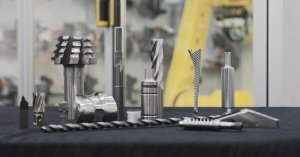
Here’s how medical instrument manufacturer Mahe Medical has successfully grown their range and market. Article by Duncan Thompson, ANCA.
Getting Ahead in the Medical Market
Here’s how medical instrument manufacturer Mahe Medical has successfully grown their range and market. Article by Duncan Thompson, ANCA.

What does it take to successfully enter a new market? Examples where one factor alone sets up an easy path for success are rare. More typically, success comes from a combination of inputs, some strategically planned, others through serendipity. Such is the case of Mahe Medical who, today, manufactures and sells a growing range of medical instruments.
Markus Heckman, Mahe co-founder and managing director, talks of some decisions and choices made along the way to becoming a successful supplier of medical instruments to global players in the orthopaedic industry.
“My brother and I learned tool grinding skills in my father’s grinding factory. But we made an early decision to move towards the medical tooling market. This allowed me to utilise knowledge picked up in completing my Medical Engineering degree,” says Markus.
Initially, he used the facilities of his father’s factory to grind medical instruments in the evenings. And then in 1993, Mahe Medical was established. Markus was soon joined by his brother, Jochen, and together they continue to work collaboratively in strategic, manufacturing and customer focused aspects of the business.
Markus and Jochen reflect on their decision to use ANCA grinders. “Our first ANCA purchase really came out of perfect timing for both ourselves and ANCA. The company from whom we purchased our first grinding machines was going out of business and we needed a new supplier that could guarantee ongoing support. Right at that time, the ANCA salesman was knocking at our door promoting RGX. Other cheaper options were available, but the immediate benefits of ANCA were obvious in the Cimulator 3D, which at the time was way ahead of anything else offered in the market. Combined with the machine software being so flexible, it was an easy choice. We found we could prepare tools that had geometries not possible on our older machines. This allowed us to work much more collaboratively with our customers to produce exactly the tools they wanted,” said Markus.
Jochen explains the continuing relationship with ANCA. “Our first purchase was based on the technical features of the machine and software which were clearly industry leading. But subsequent machine purchases were equally driven by the fantastic support we have received from ANCA over the years. Whether servicing existing machines or providing technical support for new applications, ANCA has been there with us. Most recently we took the step into producing femoral hip rasps – a whole new application that convinced us ANCA was committed to supporting us.”
This has given Mahe Medical the confidence to branch out and establish a manufacturing site in Southeast Asia. Again, with ANCA being so close by. By doing this, Mahe can now be working with and responding quickly to their customer base in that region. Today, Mahe Medical has 10 ANCA machines installed across its German and Thai manufacturing facilities.
Medical Market Challenges and Future
So, what are the challenges for today for Mahe Medical? “The medical instruments business is extremely competitive,” Markus explains. “Not only do you have regulations to consider, but margins are tight. So, we are constantly talking with ANCA about ways to make our manufacturing processes more efficient and leaner, and to keep our costs down. The FastLoad automation solutions, for example, perfectly met our needs. For a small investment, we get flexible, unmanned production for the small batch sizes we must deal with. This means manufacturing in Germany can still be competitive. This in itself is a benefit, because it brings with it an implicit recognition of German quality.”
And the future for Mahe? The brothers are optimistic and enthusiastic. “We are regularly talking with ANCA to find ways we can be more efficient with manufacturing our new applications or products that can be supported on their machines. Right now, we are closely considering other orthopaedic implant applications,” says Jochen.
For this application, ANCA offer a comprehensive programming solution by integrating Siemens NX-CAM with ANCA’s iGrind software. This makes easy work of programming the ANCA machines for grinding and milling the complex forms for hip rasps and orthopaedic knees. Additionally, services for tooling design ensure parts are accurately and rigidly held during the grinding and milling processes.
“Knowing that ANCA already has experience with this application and will continue to support us, gives us much more confidence as we continue taking steps to grow our business,” concludes Markus.
For companies skilled in cutting tool grinding, the medical industry represents an excellent opportunity for tool makers looking to diversify into a new market with outstanding prospects for ongoing growth, be it in orthopaedic or rotary instruments. Given this, ANCA has an ongoing focus on developing software that meets the needs of the medical tooling application. ANCA’s latest application software release, RN34, introduces an array of new features that allows increasingly complex tool geometries to be created with ease.
Check out these articles:
Frost & Sullivan Names Top Innovators In The Global Commercial Aircraft MRO Market
Global Aerospace Materials Market To Reach US$10.8 Billion By 2025
Collaborative Robot Market To Exceed US$11 Billion By 2030
Leuze Electronic Opens New Logistics Center In Singapore
Aicon: Automated Scanning In Production
WANT MORE INSIDER NEWS? SUBSCRIBE TO OUR DIGITAL MAGAZINE NOW!
FOLLOW US ON: LinkedIn, Facebook, Twitter
